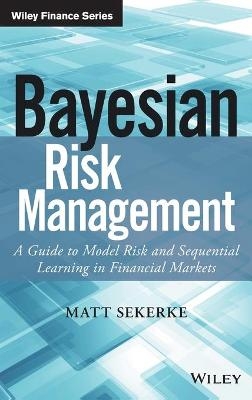
Bayesian Risk Management
John Wiley & Sons Inc (Verlag)
978-1-118-70860-6 (ISBN)
A risk measurement and management framework that takes model risk seriously Most financial risk models assume the future will look like the past, but effective risk management depends on identifying fundamental changes in the marketplace as they occur. Bayesian Risk Management details a more flexible approach to risk management, and provides tools to measure financial risk in a dynamic market environment. This book opens discussion about uncertainty in model parameters, model specifications, and model-driven forecasts in a way that standard statistical risk measurement does not. And unlike current machine learning-based methods, the framework presented here allows you to measure risk in a fully-Bayesian setting without losing the structure afforded by parametric risk and asset-pricing models.
Recognize the assumptions embodied in classical statistics
Quantify model risk along multiple dimensions without backtesting
Model time series without assuming stationarity
Estimate state-space time series models online with simulation methods
Uncover uncertainty in workhorse risk and asset-pricing models
Embed Bayesian thinking about risk within a complex organization
Ignoring uncertainty in risk modeling creates an illusion of mastery and fosters erroneous decision-making. Firms who ignore the many dimensions of model risk measure too little risk, and end up taking on too much. Bayesian Risk Management provides a roadmap to better risk management through more circumspect measurement, with comprehensive treatment of model uncertainty.
MATT SEKERKE is an economic consultant based in New York whose work focuses on the financial services industry and the application of advanced quantitative modeling techniques o financial data. He holds a BA in economics and mathematics from The Johns Hopkins University, an MA in history from The Johns Hopkins University, and an MBA in econometrics and statistics, analytic finance, and entrepreneurship from The University of Chicago Booth School of Business. He is also a CFA charterholder, a certified Financial Risk Manager, and a certified Energy Risk Professional.
Preface ix
Acknowledgments xiii
Chapter 1 Models for Discontinuous Markets 1
Risk Models and Model Risk 2
Time-Invariant Models and Crisis 3
Ergodic Stationarity in Classical Time Series Analysis 5
Recalibration Does Not Overcome the Limits of a
Time-Invariant Model 7
Bayesian Probability as a Means of Handling Discontinuity 8
Accounting for Parameter and Model Uncertainty 9
Responding to Changes in the Market Environment 12
Time-Invariance and Objectivity 14
Part One Capturing Uncertainty in Statistical Models
Chapter 2 Prior Knowledge, Parameter Uncertainty, and Estimation 19
Estimation with Prior Knowledge: The Beta-Bernoulli Model 20
Encoding Prior Knowledge in the Beta-Bernoulli Model 21
Impact of the Prior on the Posterior Distribution 23
Shrinkage and Bias 24
Efficiency 25
Hyperparameters and Sufficient Statistics 30
Conjugate Prior Families 31
Prior Parameter Distributions as Hypotheses: The Normal Linear Regression Model 31
Classical Analysis of the Normal Linear Regression Model 32
Estimation 32
Hypothesis Testing 34
Bayesian Analysis of the Normal Linear Regression Model 35
Hypothesis Testing with Parameter Distributions 39
Comparison 41
Decisions after Observing the Data: The Choice of Estimators 42
Decisions and Loss 43
Loss and Prior Information 44
Chapter 3 Model Uncertainty 47
Bayesian Model Comparison 49
Bayes Factors 49
Marginal Likelihoods 50
Parsimony 52
Bayes Factors versus Information Criteria 53
Bayes Factors versus Likelihood Ratios 54
Models as Nuisance Parameters 55
The Space of Models 56
Mixtures of Models 58
Uncertainty in Pricing Models 58
Front-Office Models 59
The Statistical Nature of Front-Office Models 61
A Note on Backtesting 62
Part Two Sequential Learning with Adaptive Statistical Models
Chapter 4 Introduction to Sequential Modeling 67
Sequential Bayesian Inference 68
Achieving Adaptivity via Discounting 71
Discounting in the Beta-Bernoulli Model 73
Discounting in the Linear Regression Model 77
Comparison with the Time-Invariant Case 81
Accounting for Uncertainty in Sequential Models 83
Chapter 5 Bayesian Inference in State-Space Time Series Models 87
State-Space Models of Time Series 88
The Filtering Problem 90
The Smoothing Problem 91
Dynamic Linear Models 94
General Form 94
Polynomial Trend Components 95
Seasonal Components 96
Regression Components 98
Building DLMs with Components 98
Recursive Relationships in the DLM 99
Filtering Recursion 99
Smoothing Recursion 102
Predictive Distributions and Forecasting 104
Variance Estimation 105
Univariate Case 106
Multivariate Case 107
Sequential Model Comparison 108
Chapter 6 Sequential Monte Carlo Inference 111
Nonlinear and Non-Normal Models 113
Gibbs Sampling 113
Forward-Filtering Backward-Sampling 114
State Learning with Particle Filters 116
The Particle Set 117
A First Particle Filter: The Bootstrap Filter 117
The Auxiliary Particle Filter 119
Joint Learning of Parameters and States 120
The Liu-West Filter 122
Improving Efficiency with Sufficient Statistics 124
Particle Learning 125
Sequential Model Comparison 126
Part Three Sequential Models of Financial Risk
Chapter 7 Volatility Modeling 131
Single-Asset Volatility 132
Classical Models with Conditional Volatility 132
Rolling-Window-Based Methods 133
GARCH Models 136
Bayesian Models 138
Volatility Modeling with the DLM 139
State-Space Models of Stochastic Volatility 140
Comparison 141
Volatility for Multiple Assets 144
EWMA and Inverted-Wishart Estimates 144
Decompositions of the Covariance Matrix 148
Time-Varying Correlations 149
Chapter 8 Asset-Pricing Models and Hedging 155
Derivative Pricing in the Schwartz Model 156
State Dynamics 157
Describing Futures Prices as a Function of Latent Factors 157
Continuous- and Discrete-Time Factor Dynamics 158
Model-Implied Prices and the Observation Equation 161
Online State-Space Model Estimates of Derivative Prices 162
Estimation with the Liu-West Filter 163
Prior Information 165
Estimation Results 166
Estimation Results with Discounting 176
Hedging with the Time-Varying Schwartz Model 188
Connection with Term-Structure Models 190
Models for Portfolios of Assets 191
Part Four Bayesian Risk Management
Chapter 9 From Risk Measurement to Risk Management 195
Results 195
Time Series Analysis without Time-Invariance 196
Preserving Prior Knowledge 196
Information Transmission and Loss 198
Bayesian State-Space Models of Time Series 199
Real-Time Metrics for Model Risk 200
Adaptive Estimates without Recalibration 202
Prior Information as an Instrument of Corporate Governance 204
References 207
Index 213
| Reihe/Serie | Wiley Finance Editions |
|---|---|
| Verlagsort | New York |
| Sprache | englisch |
| Maße | 155 x 229 mm |
| Gewicht | 476 g |
| Themenwelt | Wirtschaft ► Betriebswirtschaft / Management ► Finanzierung |
| ISBN-10 | 1-118-70860-1 / 1118708601 |
| ISBN-13 | 978-1-118-70860-6 / 9781118708606 |
| Zustand | Neuware |
| Informationen gemäß Produktsicherheitsverordnung (GPSR) | |
| Haben Sie eine Frage zum Produkt? |
aus dem Bereich



